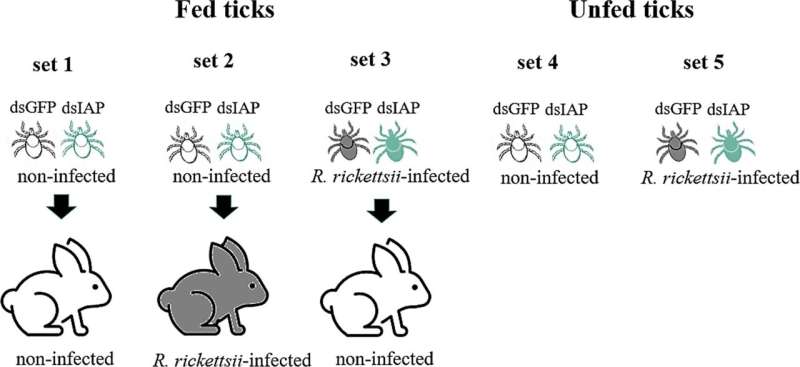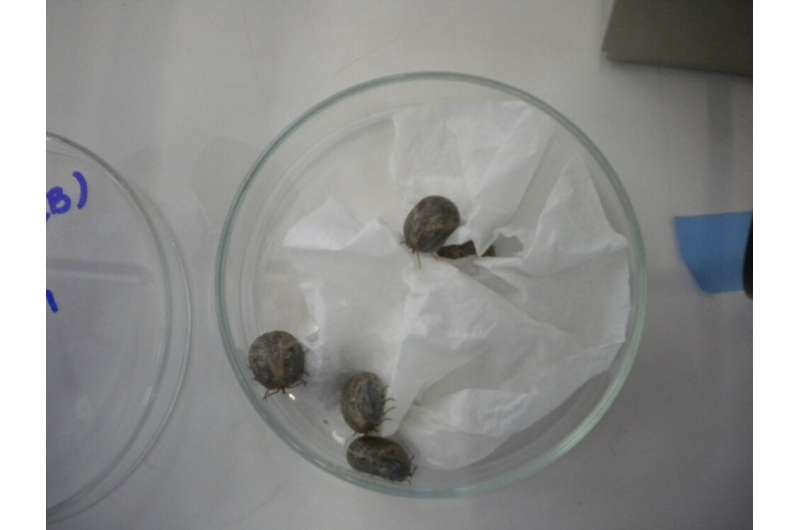This article has been reviewed according to Science X's editorial process and policies. Editors have highlighted the following attributes while ensuring the content's credibility:
fact-checked
trusted source
proofread
Study identifies potential protein target for a vaccine against spotted fever

A protein found in cells of the hard tick Amblyomma sculptum, the main vector of the bacterium that causes Brazilian spotted fever (also known as Rocky Mountain spotted fever), is essential to the tick's survival while feeding, making it a promising target for development of a vaccine, according to an article published in the journal Parasites & Vectors. The study was conducted by researchers at the University of São Paulo (USP) in Brazil.
Brazilian spotted fever is caused by the bacterium Rickettsia rickettsii, which is transmitted by A. sculptum. The disease is common in the Cerrado (Brazil's savanna-like biome) and degraded areas of Atlantic Rainforest. According to the Brazilian Ministry of Health, 160 cases were notified annually on average in the past three years, and about 28% were lethal.
Previous research by the same group of scientists, who are affiliated with the Biomedical Sciences Institute (ICB-USP), had already shown that R. rickettsii prospers in its host because it inhibits the programmed cell death (apoptosis) that controls the tick's immune response, giving the bacterium time to proliferate and infect more cells.
This latest study focused on silencing gene expression of an inhibitor of apoptosis protein (IAP) to mitigate bacterial proliferation and make the tick more resistant to infection. To this end, ticks were fed in the laboratory with blood from rabbits infected with R. rickettsii and from non-infected rabbits.

"We found that both groups, infected and non-infected, died when they fed, confirming the importance of IAPs to their survival," said Andrea Cristina Fogaça, last author of the article and a professor in the Department of Parasitology at ICB-USP. "This information suggests something more interesting than merely blocking infection, which is that it's possible to contain and even reduce the host population."
Tick mortality during the experiment exceeded 92%. These results suggest feeding generated free radicals that activated apoptosis in infected as well as non-infected ticks. The ticks could not survive without the IAP.
Focus on the host
The importance of focusing on the science of A. sculptum in order to develop a vaccine against spotted fever is clear. "Besides being a vector, the tick serves as a reservoir of R. rickettsii in the environment. Once infected, the female transmits the bacteria to its offspring, keeping them active for consecutive generations of the tick population," Fogaça said.
The next steps will include confirming that blood feeding really is the factor that promotes apoptosis via production of reactive oxygen species, validating the IAP's potential use in a vaccine, and extending the experiments to other tick species.
In addition to the medical significance of this research, which could potentially reduce transmission of the bacteria to humans, Fogaça stressed the economic impact of a vaccine that could reduce the density of the tick population infesting cattle and other livestock. Amblyomma ticks feed on the blood of mammals generally, causing anemia in cattle and damaging their hides. There are no estimates of losses to cattle farmers, but there are reports that tick infestation is increasing.
More information: Marcelly Nassar et al, The survival of Amblyomma sculptum ticks upon blood-feeding depends on the expression of an inhibitor of apoptosis protein, Parasites & Vectors (2023). DOI: 10.1186/s13071-023-05701-8
Provided by FAPESP

















